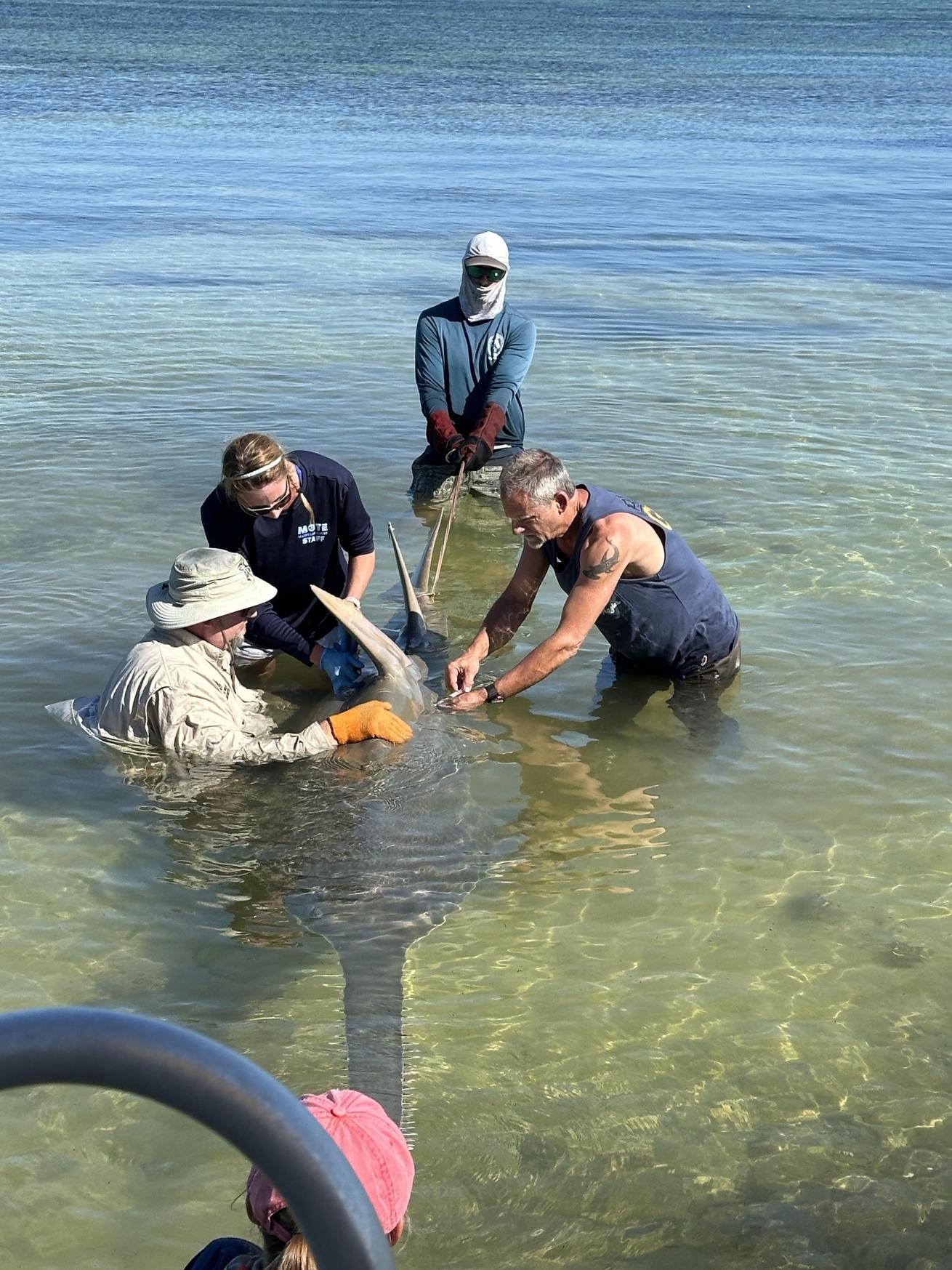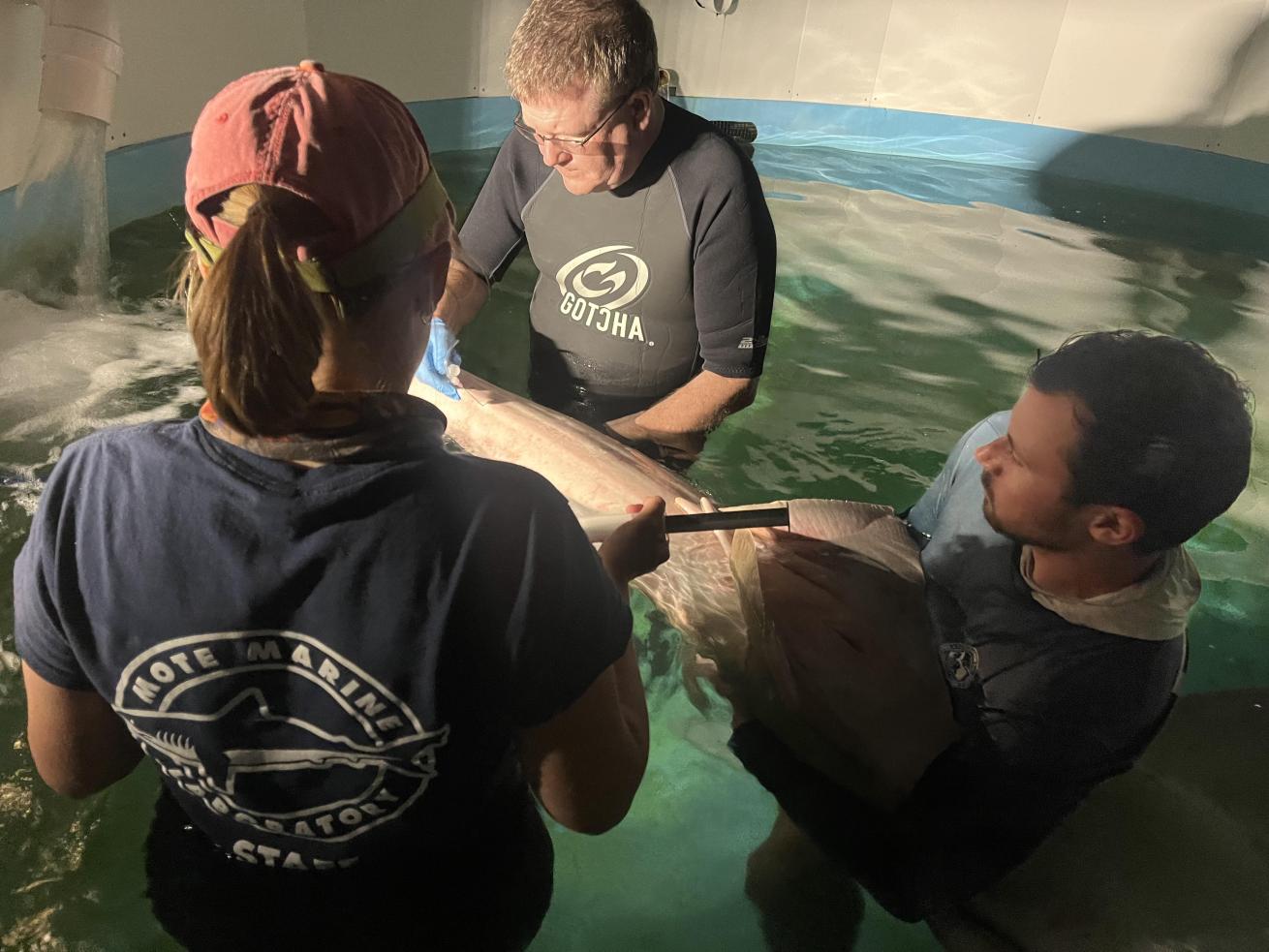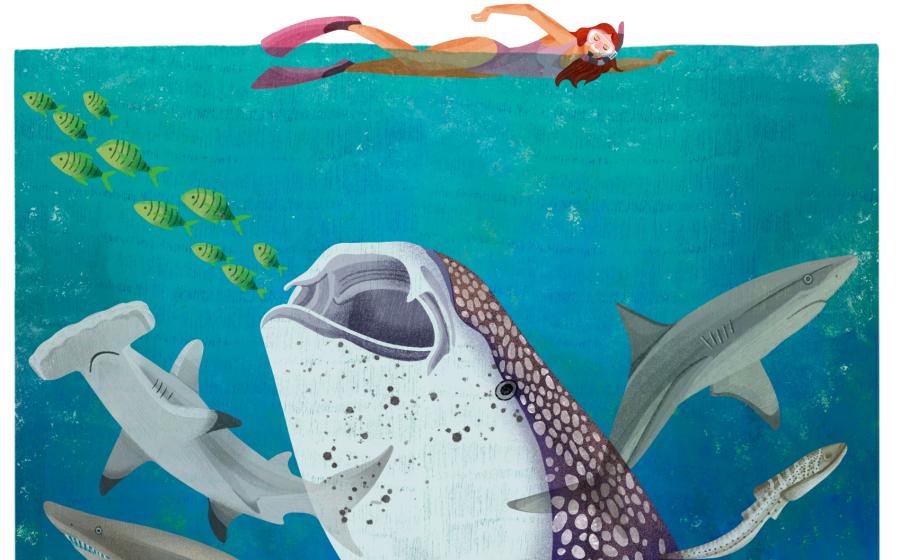Rescued Endangered Sawfish in Florida Keys Dies in Captivity
Courtesy Mote Marine LaboratorySmalltooth sawfish and other fish are still mysteriously acting strange and dying in Florida.
For the first time since unusual behavior was reported among Florida's smalltooth sawfish earlier this year, biologists managed to catch and study one affected animal. However, after 20 days of being cared for at Mote Marine Laboratory and Aquarium in Sarasota, Florida, that sawfish has died.
The rescue effort began on April 5. Mote and the Florida Fish and Wildlife Conservation Commission (FWC) responded to a distressed smalltooth sawfish after someone called the sawfish hotline and reported the animal swimming in circles in Cudjoe Bay in the Florida Keys.
Since January 2024, 47 sawfish have died, and an additional 169 sick individuals have been reported. “We expect the total mortality to be quite a bit higher,” said Adam Brame, NOAA Fisheries’ sawfish recovery coordinator.
Reports of spinning fish from the Florida Keys started in fall 2023 and smalltooth sawfish deaths were first reported the following January, according to FWC. So far, more than 50 species have been impacted. Scientists are still racing to uncover the cause of the abnormal behavior and deaths; in the meantime, NOAA Fisheries and FWC launched an emergency rescue effort for the critically endangered sawfish.

Courtesy Mote Marine LaboratoryMote and FWC complete a quick field assessment that included taking samples on April 5, 2024 in the Lower Keys.
How to Rescue a Ray
On April 5, a small team of biologists arrived on the scene via boat to the shallow canal where the sawfish was located. They moved the thrashing ray to deeper water, took measurements and collected blood samples from the animal, then assessed whether or not it was a good candidate for rescue. They considered how far away they were from a dock with a temporary holding tank, the size of the animal, their ability to keep water flowing over the ray’s gills so it could breathe and whether they had enough staff to handle the animal, said Brame. The team also had to consider the condition of the sawfish. “It's sick, but it was also responsive and had some vitality—it was still kicking and had a little pep in it.”
Ultimately, the rescuers decided to save the ray. “It was an animal that needed to be rescued. The rescue attempt itself would cause no greater harm to the animal, and it was safe for the humans,” said Michael P. Crosby, president and CEO of Mote.
The sawfish remained in the holding tank in the Florida Keys with 24/7 monitoring and care until it was stable enough to be transported to a more permanent location at Mote’s main site in Sarasota. The 11.5-foot male took a 7-hour drive to Mote’s facility via a specialized transport trailer operated by Ripley’s Aquariums; it was closely monitored by the team the entire time.
Related Reading: Coldwater Dispatches: Polar Jellyfish

Courtesy Mote Marine LaboratoryThe rescued sawfish in the temporary holding tank at Mote’s facility.
Care at the Aquarium
Once at Mote, the sawfish was stabilized, but was still in critical condition, said Crosby. It received vitamins, fluids, nutrition and lipid-based compounds to help absorb any toxins that could be the cause of the distressed behavior. Before dying, the neurological symptoms disappeared, and it was swimming and resting, though not eating on its own.
“I don't know that the rescue could have gone much better,” Brame said. “The fact that within a couple of days of getting all the permissions in place, we could make a rescue attempt and be successful in getting that animal from the wild into care has been remarkable. While it’s unfortunate the animal died,” he added, “it wasn’t totally unexpected.”
Related Reading: Why You Shouldn’t Feed Lionfish to Sharks
While the animal was still alive, scientists learned more each day by observing its behavior and comparing it to the wild, affected sawfish they haven’t been able to rescue. Once it died, scientists performed a necropsy—an animal autopsy—and collected more blood and tissue samples. However, necropsies do not always determine the cause of death.
“We hope we can identify the active agent—the smoking gun, if you will—soon because that then can help target treatments much more efficiently and effectively. But it could be years [before we find that], if ever,” Crosby said. “We are working in a very scientifically based, hypothesis-driven initiative to try to determine what it is in other species that are exhibiting this behavior as well, because if we find the agent of cause in any of these species, that's going to be helpful to all the species—especially this endangered smalltooth sawfish.”
Courtesy Mote Marine LaboratoryThe rescued sawfish in rehab at Mote
A Sign of Hope
According to Brame, since the rescue, the number of reports has gone down, which means there haven’t been many opportunities for additional rescues. “We're not going to complain about it. I think that's a good thing. But we don't know why there's been this reduction in opportunities,” he said. Is it potentially reporting fatigue from the public? Is it based on their normal movement patterns and the animals not being concentrated in the Florida Keys in the spring? Or are conditions returning to normal? A hopeful Brame suggested that perhaps “nature is taking care of itself and whatever the causative agent was has abated? We don't know.” Time will tell—maybe.
FWC continues to monitor the hotline. Public reports are an essential resource for the investigation into this event, according to FWC. If you see a sawfish in distress, call (844) 4-SAWFISH or email [email protected]







